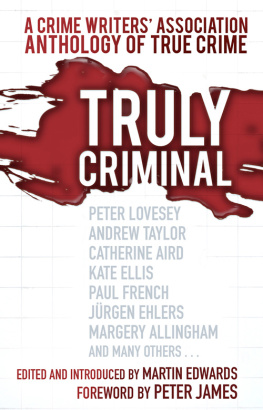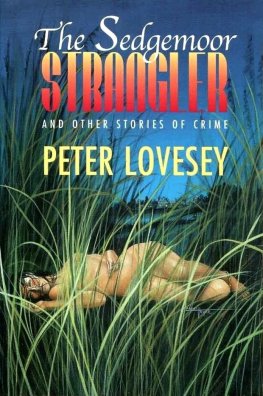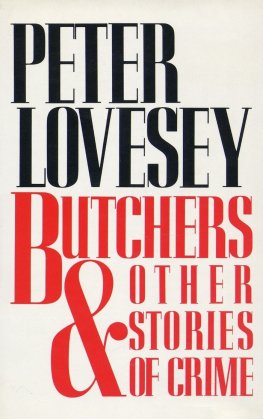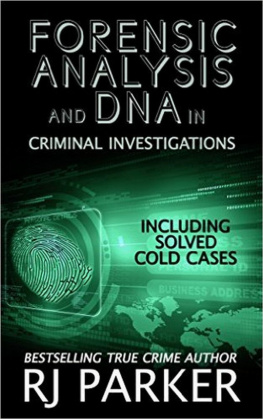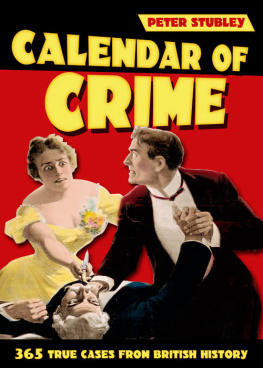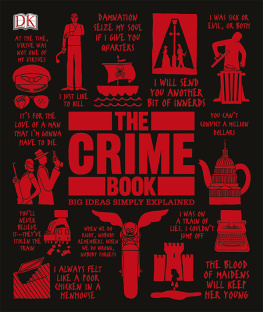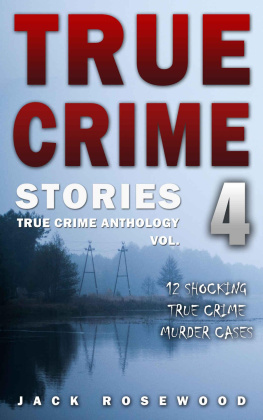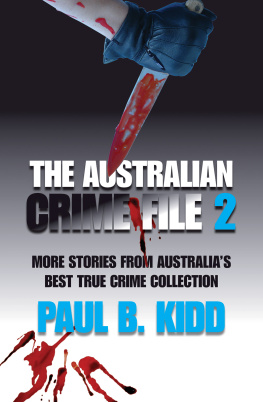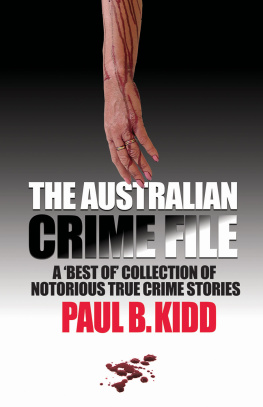
CONTENTS
by
PETER JAMES
by
MARTIN EDWARDS
CATHERINE AIRD
MARGERY ALLINGHAM
MARTIN BAGGOLEY
QUENTIN BATES
KATE CLARKE
CAROL ANNE DAVIS
JIM DOHERTY
MARTIN EDWARDS
JRGEN EHLERS (translated by Ann-Kathrin Ehlers)
KATE ELLIS
PAUL FRENCH
PETER GUTTRIDGE
BRIAN INNES
DIANE JANES
JOAN LOCK
PETER LOVESEY
LINDA STRATMANN
ANDREW TAYLOR
MARSALI TAYLOR
STEPHEN WADE
MARK MOWER

PETER JAMES
Peters seven consecutive Sunday Times No. 1 bestselling Roy Grace crime novels are published in thirty-six languages with sales of over fifteen million copies. They have also been No. 1 bestsellers in France, Germany, Spain, Russia, and Canada. His latest novel is Want You Dead and he has recently published a volume of short stories, A Twist of the Knife. He lives in Notting Hill, London and near Brighton in Sussex. He is a past chair of the Crime Writers Association and is on the board of International Thriller Writers in the US.
www.peterjames.com
PETER JAMES
People often say to me, You must have a very warped mind to come up with some of the stuff you write. Where on earth does it all come from?
I dont think I have a particularly warped mind, I reply. I just read a lot of newspapers!
There are few occasions, I believe, when an author conjures something from his or her imagination that is more bizarre or horrific than a true-life occurrence. That old saw, Truth is stranger than fiction , is one we are all familiar with. Its an expression we use when we dismiss, with a smile, yet another headline news story, whether in a paper, or on television or on the Internet, that leaves us once more pondering or reeling at the discovery of yet another bizarre, hideous or utterly repugnant aspect of human nature. One such example for me and I think for many of us was, in recent times, the news story, and footage, about a British soldier savagely attacked and beheaded on a South London street. Im not sure that anyone would have believed that possible if theyd first read it as fiction.
Whenever I go out with the police in the course of my research for my novels, either here in my native Sussex, or in London, or in the USA, or Germany or anywhere else, Im constantly reminded just how true that saying is. I remember entering a flat on Brighton seafront where a woman had lain dead for two months, locked in with her cats. They had eaten her face and much of her upper torso. A Johannesburg police officer told me only a few weeks ago of a house burglary during which, for fun, the burglars had poured boiling water down an old ladys throat. And an LA cop told me of a victim he had attended, who had been involved in drug dealings that had gone wrong, and who had been skinned alive in punishment.
One of the USs most notorious serial killers had a penchant for disembowelling his victims while they were still alive, and then masturbating in front of them while he watched. Not necessarily the stuff we want to write in books, but sadly stuff that actually happened in true life.
Countless of our greatest crime novels, right back to The Hound of the Baskervilles and beyond that, owe their origins to true stories. Some of these books have been game-changers in the world of crime fiction. Thats certainly true of Truman Capotes 1966 In Cold Blood , the non-fiction account of a quadruple homicide in Kansas, which became the biggest selling crime book of its time. Thomas Harriss The Silence of the Lambs in 1988 both changed the rules and raised the bar on crime fiction. The protagonist, Buffalo Bill, who liked to make suits out of human skin, was inspired by Ed Gein, an American bodysnatcher who liked to skin his victims and make artefacts out of it and their bones.
When I go out with the police, I watch, I listen, I remember. And pretty often I have nightmares. For fiction is fiction, storytelling, mining the deep seams of our imagination and making our readers do the same. But true crime is different, true crime is truly the stuff of nightmares.
Ive often heard it, from detectives, from lawyers and from forensic psychiatrists, that with few exceptions all murders are committed for one of two reasons: for money or love. I think you will find good examples of both in the pages that follow.
So will you be able to read this marvellously disturbing collection of accounts of very dark deeds, whilst safely tucked up in bed, late in the evening, without suffering nightmares from the contents yourselves? I have my share of nightmares both from what I read and from what I write. I think it is no bad thing that stories like these should shock us. I think it would be far more disturbing, in what they say about us, if they did not.
Peter James
MARTIN EDWARDS
Members of the Crime Writers Association (CWA) have always been fascinated by real-life criminal cases. A good many of our members specialise in writing true crime (this is not a universally popular term, but at least it has the merit that it is generally understood) and the CWA has awarded a Gold Dagger for Non-Fiction since 1978. The Dagger has been won by many accomplished exponents of factual crime writing.
The CWA has, however, only once before published a collection of pieces by members about real life crimes. Blood on My Mind , edited by H.R.F. Keating, and including ten essays, appeared as long ago as 1972. Having edited the CWAs annual fiction anthology since the mid-1990s, I felt it was high time for us to put together another book of original essays on the theme of, to quote the sub-title of Blood on My Mind , real crimes, some notable and some obscure.
I was delighted by the response from members, some of whom have not previously contributed to CWA anthologies. Our contributors include several specialists in true crime (although most of them write fiction as well), including Kate Clarke, who with Bernard Taylor was co-author of Murder at the Priory , shortlisted for the CWA Non-Fiction Dagger in 1988. Paul French, who won the Dagger in 2013 with Midnight in Peking , returns to China with his essay. In the spirit of originality that characterises the contributions, Linda Stratmanns impeccably researched essay includes a special bonus a highly appropriate recipe for rice pottage, updated from the nineteenth-century original. As she says, arsenic should not be added
Several leading novelists also made fascinating submissions. They included two CWA Diamond Dagger winners, Peter Lovesey and Andrew Taylor, as well as Catherine Aird and Kate Ellis. The CWAs membership is increasingly international, and I was pleased to receive contributions from Quentin Bates (a Brit who lives in Iceland), Jrgen Ehlers from Germany, and Jim Doherty from the US.
All but one of the contributions to this book are brand new. This exception is a real find. Thanks to the good offices of Barry Pike and Julia Jones of the Margery Allingham Society, to whom Im extremely grateful, I have been lucky enough to include an essay by Allingham about the Wallace case that was unpublished during her lifetime, and has previously only appeared in the Societys journal for members. Margery Allingham was a member of the CWA, and a pleasing connection with her past involvement arose last year when the Society sponsored a national short story prize in tandem with the CWA.
The Wallace case has fascinated writers for over eighty years. Dorothy L. Sayers wrote an excellent study of it, and Raymond Chandler was fascinated by the puzzle. More recently, the late P.D. James published a thoughtful reassessment of the question about whether Wallace murdered his wife. Allinghams essay makes an interesting companion piece to the extensive literature about the case, though the only thing of which we can be sure is that the debate will continue.
Next page
